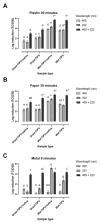Virucidal Efficacy of Blue LED and Far-UVC Light Disinfection against Feline Infectious Peritonitis Virus as a Model for SARS-CoV-2
- PMID: 34452302
- PMCID: PMC8402852
- DOI: 10.3390/v13081436
Virucidal Efficacy of Blue LED and Far-UVC Light Disinfection against Feline Infectious Peritonitis Virus as a Model for SARS-CoV-2
Abstract
Transmission of the severe acute respiratory syndrome coronavirus 2 (SARS-CoV-2) occurs through respiratory droplets passed directly from person to person or indirectly through fomites, such as common use surfaces or objects. The aim of this study was to determine the virucidal efficacy of blue LED (405 nm) and far-UVC (222 nm) light in comparison to standard UVC (254 nm) irradiation for the inactivation of feline infectious peritonitis virus (FIPV) on different matrices as a model for SARS-CoV-2. Wet or dried FIPV on stainless steel, plastic, or paper discs, in the presence or absence of artificial saliva, were exposed to various wavelengths of light for different time periods (1-90 min). Dual activity of blue LED and far-UVC lights were virucidal for most wet and dried FIPV within 4 to 16 min on all matrices. Individual action of blue LED and far-UVC lights were virucidal for wet FIPV but required longer irradiation times (8-90 min) to reach a 4-log reduction. In comparison, LED (265 nm) and germicidal UVC (254 nm) were virucidal on almost all matrices for both wet and dried FIPV within 1 min exposure. UVC was more effective for the disinfection of surfaces as compared to blue LED and far-UVC individually or together. However, dual action of blue LED and far-UVC was virucidal. This combination of lights could be used as a safer alternative to traditional UVC.
Keywords: 405 nm blue light; coronavirus; far-UVC; feline infectious peritonitis virus; light disinfection; pandemic; ultraviolet light; viral inactivation.
Conflict of interest statement
The authors declare no conflict of interest. The funders had no role in the design of the study; in the collection, analyses, or interpretation of data; in the writing of the manuscript; or in the decision to publish the results.
Figures


Similar articles
-
Disinfection of SARS-CoV-2 Contaminated Surfaces of Personal Items with UVC-LED Disinfection Boxes.Viruses. 2021 Mar 31;13(4):598. doi: 10.3390/v13040598. Viruses. 2021. PMID: 33807470 Free PMC article.
-
UV Inactivation of SARS-CoV-2 across the UVC Spectrum: KrCl* Excimer, Mercury-Vapor, and Light-Emitting-Diode (LED) Sources.Appl Environ Microbiol. 2021 Oct 28;87(22):e0153221. doi: 10.1128/AEM.01532-21. Epub 2021 Sep 8. Appl Environ Microbiol. 2021. PMID: 34495736 Free PMC article.
-
Effect of intermittent irradiation and fluence-response of 222 nm ultraviolet light on SARS-CoV-2 contamination.Photodiagnosis Photodyn Ther. 2021 Mar;33:102184. doi: 10.1016/j.pdpdt.2021.102184. Epub 2021 Jan 20. Photodiagnosis Photodyn Ther. 2021. PMID: 33484873 Free PMC article.
-
COVID-19 pandemic lesson learned- critical parameters and research needs for UVC inactivation of viral aerosols.J Hazard Mater Adv. 2022 Nov;8:100183. doi: 10.1016/j.hazadv.2022.100183. Epub 2022 Oct 12. J Hazard Mater Adv. 2022. PMID: 36619826 Free PMC article. Review.
-
Viral Inactivation with Emphasis on SARS-CoV-2 Using Physical and Chemical Disinfectants.ScientificWorldJournal. 2021 Oct 25;2021:9342748. doi: 10.1155/2021/9342748. eCollection 2021. ScientificWorldJournal. 2021. PMID: 34712107 Free PMC article. Review.
Cited by
-
Effect of inactivating RNA viruses by coupled UVC and UVA LEDs evaluated by a viral surrogate commonly used as a genetic vector.Biomed Opt Express. 2022 Jul 28;13(8):4429-4444. doi: 10.1364/BOE.468445. eCollection 2022 Aug 1. Biomed Opt Express. 2022. PMID: 36032577 Free PMC article.
-
UV 254 nm is more efficient than UV 222 nm in inactivating SARS-CoV-2 present in human saliva.Photodiagnosis Photodyn Ther. 2022 Sep;39:103015. doi: 10.1016/j.pdpdt.2022.103015. Epub 2022 Jul 14. Photodiagnosis Photodyn Ther. 2022. PMID: 35843562 Free PMC article.
-
Stability of SARS-CoV-2 in cold-chain transportation environments and the efficacy of disinfection measures.Front Cell Infect Microbiol. 2023 Apr 19;13:1170505. doi: 10.3389/fcimb.2023.1170505. eCollection 2023. Front Cell Infect Microbiol. 2023. PMID: 37153150 Free PMC article.
-
Analysis of the SARS-CoV-2 inactivation mechanism using violet-blue light (405 nm).Appl Environ Microbiol. 2025 Jun 18;91(6):e0040325. doi: 10.1128/aem.00403-25. Epub 2025 May 14. Appl Environ Microbiol. 2025. PMID: 40366184 Free PMC article.
-
Viricidal Efficacy of a 405-nm Environmental Decontamination System for Inactivation of Bacteriophage Phi6: Surrogate for SARS-CoV-2.Photochem Photobiol. 2023 Nov-Dec;99(6):1493-1500. doi: 10.1111/php.13798. Epub 2023 Mar 16. Photochem Photobiol. 2023. PMID: 36872097 Free PMC article.
References
-
- World Health Organization Origins of SARS-CoV-2. [(accessed on 16 June 2021)]; Available online: https://apps.who.int/iris/bitstream/handle/10665/332197/WHO-2019-nCoV-FA....
-
- World Health Organization Worldometer COVID-19 Coronavirus Pandemic. [(accessed on 28 May 2021)]; Available online: https://www.worldometers.info/coronavirus/
-
- Gorbalenya A.E., Baker S.C., Baric R.S., de Groot R.J., Drosten C., Gulyaeva A.A., Haagmans B.L., Lauber C., Leontovich A.M., Neuman B.W., et al. The species Severe acute respiratory syndrome-related coronavirus: Classifying 2019-nCoV and naming it SARS-CoV-2. Nat. Microbiol. 2020;5:536–544. - PMC - PubMed
Publication types
MeSH terms
Grants and funding
LinkOut - more resources
Full Text Sources
Medical
Miscellaneous

